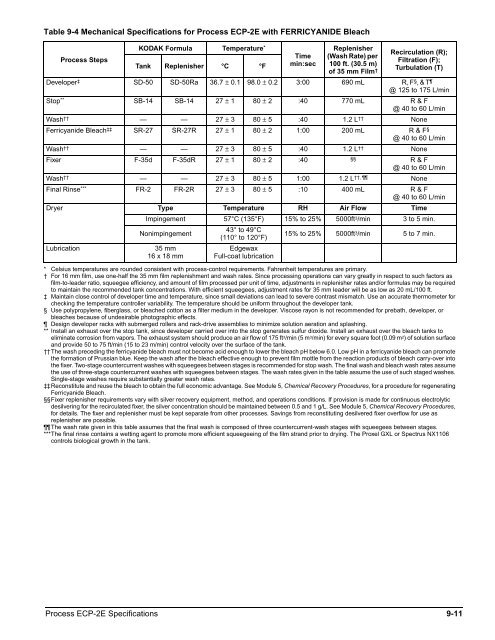Process ECP-2E Specifications - Kodak
Process ECP-2E Specifications - Kodak
Process ECP-2E Specifications - Kodak
Create successful ePaper yourself
Turn your PDF publications into a flip-book with our unique Google optimized e-Paper software.
Table 9-4 Mechanical <strong>Specifications</strong> for <strong>Process</strong> <strong>ECP</strong>-<strong>2E</strong> with FERRICYANIDE Bleach<br />
<strong>Process</strong> Steps<br />
KODAK Formula Temperature *<br />
Tank Replenisher °C °F<br />
Time<br />
min:sec<br />
Replenisher<br />
(Wash Rate) per<br />
100 ft. (30.5 m)<br />
of 35 mm Film †<br />
Recirculation (R);<br />
Filtration (F);<br />
Turbulation (T)<br />
Developer ‡<br />
SD-50 SD-50Ra 36.7 ± 0.1 98.0 ± 0.2 3:00 690 mL R, F §, & T <br />
@ 125 to 175 L/min<br />
Stop **<br />
SB-14 SB-14 27 ± 1 80 ± 2 :40 770 mL R & F<br />
@ 40 to 60 L/min<br />
Wash ††<br />
— — 27 ± 3 80 ± 5 :40 1.2 L †† None<br />
Ferricyanide Bleach ‡‡ SR-27 SR-27R 27 ± 1 80 ± 2 1:00 200 mL R & F §<br />
@ 40 to 60 L/min<br />
Wash †† — — 27 ± 3 80 ± 5 :40 1.2 L †† None<br />
Fixer F-35d F-35dR 27 ± 1 80 ± 2 :40 §§<br />
R & F<br />
@ 40 to 60 L/min<br />
Wash †† — — 27 ± 3 80 ± 5 1:00 1.2 L ††, <br />
None<br />
Final Rinse ***<br />
FR-2 FR-2R 27 ± 3 80 ± 5 :10 400 mL R & F<br />
@ 40 to 60 L/min<br />
Dryer Type Temperature RH Air Flow Time<br />
Impingement 57°C (135°F) 15% to 25% 5000ft3/min 3 to 5 min.<br />
Nonimpingement<br />
Lubrication 35 mm<br />
16 x 18 mm<br />
43° to 49°C<br />
(110° to 120°F)<br />
Edgewax<br />
Full-coat lubrication<br />
15% to 25% 5000ft 3/min 5 to 7 min.<br />
* Celsius temperatures are rounded consistent with process-control requirements. Fahrenheit temperatures are primary.<br />
† For 16 mm film, use one-half the 35 mm film replenishment and wash rates. Since processing operations can vary greatly in respect to such factors as<br />
film-to-leader ratio, squeegee efficiency, and amount of film processed per unit of time, adjustments in replenisher rates and/or formulas may be required<br />
to maintain the recommended tank concentrations. With efficient squeegees, adjustment rates for 35 mm leader will be as low as 20 mL/100 ft.<br />
‡ Maintain close control of developer time and temperature, since small deviations can lead to severe contrast mismatch. Use an accurate thermometer for<br />
checking the temperature controller variability. The temperature should be uniform throughout the developer tank.<br />
§ Use polypropylene, fiberglass, or bleached cotton as a filter medium in the developer. Viscose rayon is not recommended for prebath, developer, or<br />
bleaches because of undesirable photographic effects.<br />
Design developer racks with submerged rollers and rack-drive assemblies to minimize solution aeration and splashing.<br />
** Install an exhaust over the stop tank, since developer carried over into the stop generates sulfur dioxide. Install an exhaust over the bleach tanks to<br />
eliminate corrosion from vapors. The exhaust system should produce an air flow of 175 ft3/min (5 m3/min) for every square foot (0.09 m2) of solution surface<br />
and provide 50 to 75 ft/min (15 to 23 m/min) control velocity over the surface of the tank.<br />
††The wash preceding the ferricyanide bleach must not become acid enough to lower the bleach pH below 6.0. Low pH in a ferricyanide bleach can promote<br />
the formation of Prussian blue. Keep the wash after the bleach effective enough to prevent film mottle from the reaction products of bleach carry-over into<br />
the fixer. Two-stage countercurrent washes with squeegees between stages is recommended for stop wash. The final wash and bleach wash rates assume<br />
the use of three-stage countercurrent washes with squeegees between stages. The wash rates given in the table assume the use of such staged washes.<br />
Single-stage washes require substantially greater wash rates.<br />
‡‡Reconstitute and reuse the bleach to obtain the full economic advantage. See Module 5, Chemical Recovery Procedures, for a procedure for regenerating<br />
Ferricyanide Bleach.<br />
§§Fixer replenisher requirements vary with silver recovery equipment, method, and operations conditions. If provision is made for continuous electrolytic<br />
desilvering for the recirculated fixer, the silver concentration should be maintained between 0.5 and 1 g/L. See Module 5, Chemical Recovery Procedures,<br />
for details. The fixer and replenisher must be kept separate from other processes. Savings from reconstituting desilvered fixer overflow for use as<br />
replenisher are possible.<br />
The wash rate given in this table assumes that the final wash is composed of three countercurrent-wash stages with squeegees between stages.<br />
***The final rinse contains a wetting agent to promote more efficient squeegeeing of the film strand prior to drying. The Proxel GXL or Spectrus NX1106<br />
controls biological growth in the tank.<br />
<strong>Process</strong> <strong>ECP</strong>-<strong>2E</strong> <strong>Specifications</strong> 9-11
















